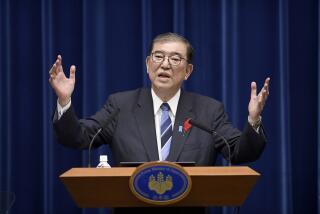Obuchi Coma Exposes Japan’s Succession Flaw
- Share via
TOKYO — When Japan’s prime minister falls ill or dies, who’s in charge?
Whomever the prime minister himself decides to appoint--if indeed he still has the faculties to name anyone. And if he’s not able, well, it’s anyone’s guess where the buck stops in the world’s second-largest economy.
The “who’s in charge” question has come into sharp focus in the past several days, after then-Prime Minister Keizo Obuchi fell into a coma April 2--and, as it turns out, didn’t exactly anoint the official who stepped in to fill the void.
The murky nature of the process has prompted cries from the press and the public for a clear-cut succession order, which newly elected Prime Minister Yoshiro Mori and his Cabinet are said to be considering.
“It’s extremely dangerous and really scary that we have none and that we didn’t even realize it,” said Tomioka Kenichi, 30, who works at a Tokyo bank.
Chief Cabinet Minister Mikio Aoki first claimed that Obuchi, just two hours before slipping into a coma from which he hasn’t emerged, had asked him to take the reins. But when grilled by parliament this week, Aoki acknowledged that he had inferred Obuchi’s intention rather than hearing it in so many words. More precisely, Obuchi had told him, “If something happens to me, please make sure that everything goes all right,” Aoki told parliament.
The ill-defined transition at the nation’s top levels illustrates the opaque nature of Japanese politics. In the country’s parliamentary democracy, the two legislative houses elect the prime minister, who is selected by his party. The only law now on the books dictates that the prime minister appoint an acting prime minister if he is incapacitated, but it gives no other specifics.
In contrast, in the United States it is clearly specified who will assume the presidential duties: the vice president, then the speaker of the House of Representatives, the president pro tem of the Senate and the secretary of State.
The hazy events surrounding Aoki’s short-lived ascension to acting prime minister bear some resemblance to the notorious--though erroneous--”I’m in charge” claim that then-Secretary of State Alexander M. Haig Jr. made when President Reagan was shot in 1981.
The only time a Japanese prime minister had previously been incapacitated in office was the year before Reagan was shot, when Masayoshi Ohira collapsed and died and was quickly replaced by the chief Cabinet secretary; a successor was elected a month later.
So why doesn’t Japan just name a vice prime minister? Some past Japanese Cabinets have done so, although it’s been purely on an ad hoc basis.
But that can be politically dangerous. In the past, such posts have been largely ceremonial, bestowed to “eliminate the pain” of rival factions that have not won the top spot, said Takashi Inoguchi, professor at Tokyo University. However, the prime minister wouldn’t want that rival faction official gaining any clout from ascending to the acting prime minister post.
Why not designate some other post as the clear successor? Because so much of Japanese politics is “situational,” Inoguchi said, meaning it depends on issues such as who’s in power, who owes what to whom and what deals have been struck.
Even if Mori announces a succession plan, as expected, it isn’t clear whether he will simply announce who his temporary successor would be, that way leaving it up to each future Cabinet to decide a successor itself, or call for permanent legislation designating that a particular Cabinet position would take over in all cases.
Media reports say that Mori is likely to designate Chief Cabinet Secretary Aoki to be second in command, again. Why Aoki? The answer is equally strange, by U.S. standards. He’s widely reported not to aspire to gain the prime minister post permanently and thus poses no threat.
“The chief Cabinet secretary is more like a banto--a kind of chief clerk, not a big-name position like a minister of finance or foreign affairs, which would be a more appropriate choice,” said lawmaker Tatsuo Kawabata.
Kawabata and others also decried the widely speculated choice of Aoki as successor because he has acknowledged deceiving the public not only about Obuchi’s instructions, but also about the critical nature of his illness. Two hours after Obuchi fell into a coma, Aoki told a news conference that he didn’t have knowledge of Obuchi’s condition.
“He hid Obuchi’s sickness and he lied to the public, and this person is being appointed as possible No. 1?” said Nobuaki Futami, a lawmaker from the opposition Liberal Party. “But since Aoki recommended that Mori be prime minister, Mori owes Aoki.”
For all the fuss in the Western media, there was remarkably little fanfare in Japan about the change in government leaders. Then again, it’s old hat here: There have been eight prime ministers in the past decade.
Moreover, the position is not nearly as powerful as comparable posts in the West: Like almost everything in Japan, government is by consensus among not only legislators, but also bureaucrats, who wield enormous power, and big business groups.
And so it is that even as numerous Japanese interviewed in downtown Tokyo criticized the lack of accountability in their system and the closed-door decision-making at the top, they simultaneously shrugged these off with tacit acceptance.
“It’s just the typical Japanese modus operandi,” said Tetsuya Yamazaki, 38, a television film producer. “Things that are acceptable here would never be tolerated if they happened in America.”
More to Read
Sign up for Essential California
The most important California stories and recommendations in your inbox every morning.
You may occasionally receive promotional content from the Los Angeles Times.













